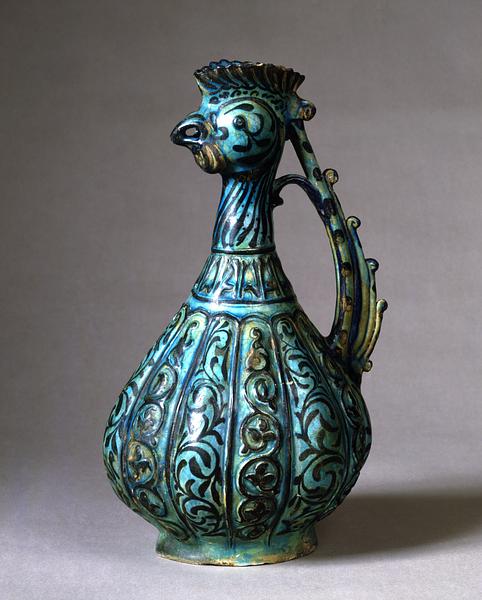Fritware ewer, molded and painted in black and blue under a transparent, turquoise glaze
Iran, Kashan; beginning of 13th century
H: 35.5; Diam: 21 cm
The frit mass could be used to create thin-walled pieces, but was also suitable for making larger, more sculptural forms. From the second half of the 12th century, vessels were made in Kashan in the shape of animals, and cock-shaped ewers seem to have been very much in demand.
The liquid in the ewer is poured from the beak in two jets, and the handle is shaped like tail feathers. The naturalistic elements are not allowed to dominate, however. The body is covered with vertical sections with vegetal ornaments alternately in painted relief and painted only with the vine scrolls that were characteristic of Kashan in this period. A band with a pseudo-inscription runs around the ewer’s neck.
Inv. no. Isl 23
Published in:
Catalogue of the International exhibition of Persian art at the Royal Academy of Arts, 3. ed. Royal Academy of Arts, London 1931, p. 63, cat. 101a;
Arthur Upham Pope and Phyllis Ackerman (eds.): A survey of Persian art: from prehistoric times to the present, London 1938-39, pl. 742a;
C.L. Davids Samling : Nogle Studier, København 1948, pp. 78-79;
Gudmund Boesen: Danish museums, Publ.by the Committee for Danish Cultural Activities Abroad, Copenhagen 1966, p. 107;
André Leth: Davids Samling. Islamisk kunst = The David Collection. Islamic Art, København 1975, pp. 37-38;
The arts of Islam : Hayward gallery, 8 April - 4 July 1976, London 1976, cat. 358;
Tsugio Mikami: Islamic pottery, Tokyo 1986, cat. 144, p. 155;
Kjeld von Folsach: Islamic art. The David Collection, Copenhagen 1990, cat. 118;
Kjeld von Folsach: Art from the World of Islam in The David Collection, Copenhagen 2001, cat. 172;
Sheila S. Blair and Jonathan M. Bloom (eds.): Cosmophilia. Islamic Art from the David Collection, Copenhagen, McMullen Museum of Art, Boston College, Boston 2006, cat. 119;
